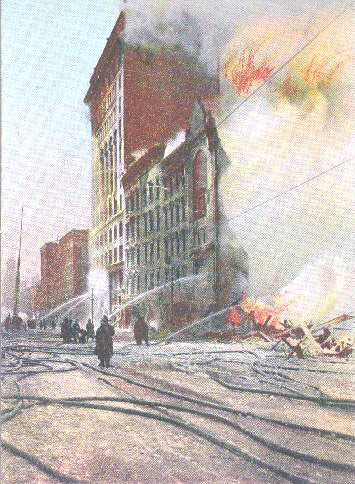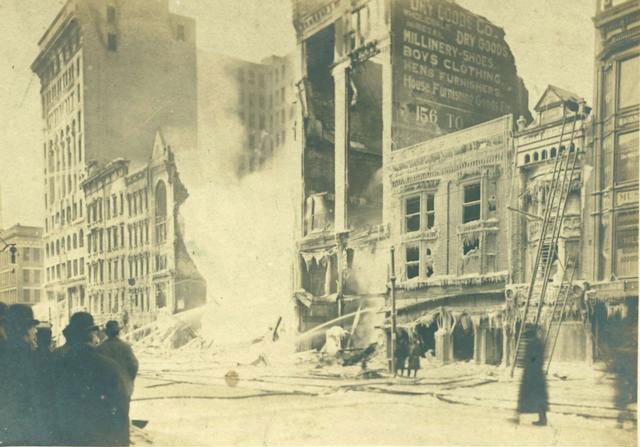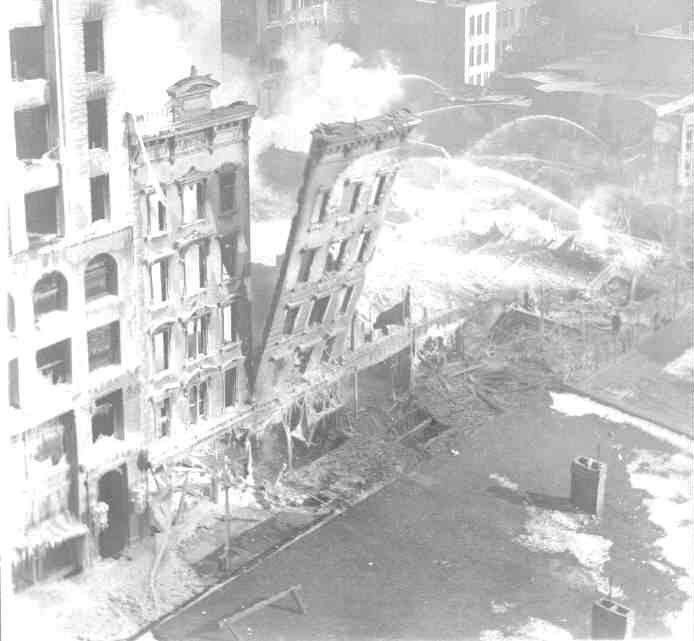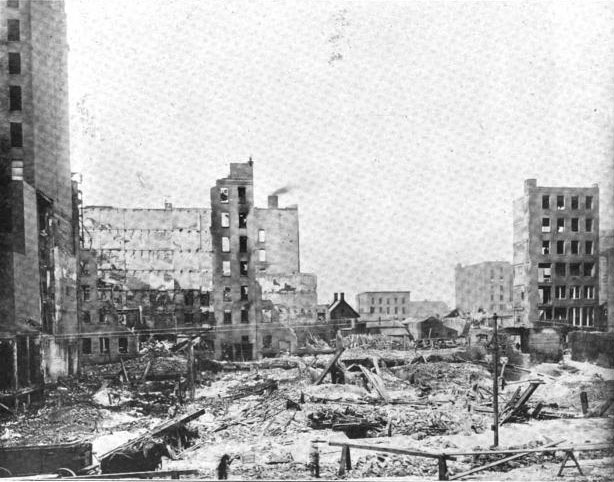This article was scraped from Rochester Subway. This is a blog about Rochester history and urbanism has not been published since 2017. The current owners are now publishing link spam which made me want to preserve this history.. The original article was published February 26, 2011 and can be found here.

On February 26, 1904 a fire leveled 1 3/4 acres of the Main Street shopping district. The fire started in the Rochester Dry Goods Company and the flames quickly spread west to Saint Paul Street and north across Division Street via a footbridge. Faulty electrical wires in an elevator shaft were to blame. More photos after the jump ...

The fire burned for more than six hours before it was under control but wasn't officially declared "out" for 40 hours. The estimated loss was about three million dollars. It was one of Rochester's most damaging fires and became known as the Sibley fire because the Sibley, Lindsay & Curr Co. suffered the heaviest loss. The Granite Building which still stands at the corner of Main and Saint Paul St. was completely gutted by the fire but survived thanks largely to its "fireproof" iron and concrete construction. Below are a few excerpts from a New York Times article (Feb. 26, 1904)

and some photos... ROCHESTER SWEPT BY GREAT FIRE Business District Suffers Four to Five Million Dollars Loss. OTHER CITIES SEND HELP Three City Blocks Burned Over--Blaze Probably Caused by Defective Electric Wire. ROCHESTER, N.Y., Feb. 26. -- The most disastrous fire in the history of Rochester raged from 5 o'clock this morning until afternoon. Before the Fire Department, assisted by reinforcements from Syracuse and Buffalo, had checked the flames they had swept the retail clothing and dry goods district for a space of three blocks and had inflicted a loss which is now estimated by insurance experts at from $4,000,000 to $5,000,000.

The fire was discovered by the night watchman in the employ of the Rochester Dry Goods Company, who says it started from a fuse which blew out in the electric elevator connection. Almost simultaneously an explosion occurred in the basement of Beadle & Sherburnes's store, next door. Smoke and flames poured through the elevator grating in the sidewalk, and in an incredibly short time the buildings were a mass of flame. Secretary Carey of the Rochester Dry Goods Company, in whose building the fire started, attributes the fire to deficient electric wiring. "Our elevator is run by electricity," he said, "and the power is left on each night so that the night watchman can use the car to get to the floors above. I think that the fire was caused by the electric wires, as it started around the centre elevator."

Only the front wall of the Marble Building is standing at to-night. The shell of the Granite Building is intact, and the floors are in place, but the building has been gutted.

There were no casualties and no one was injured, with the exception that Assistant Chief Jaynes, who was struck by a flying nozzle, received some bruises.

Soon after the department arrived at the scene of the fire it was perceived that the blaze was likely to prove too much for the local firemen, and Buffalo and Syracuse were asked for help. Engines from both cities were started for Rochester within half an hour after the call for aid was received. As soon as Fire Chief Quigley of Syracuse received the appeal for aid he ordered his men to man their engines and hasten to the railroad station, where a special train was quickly made ready...The start was made at 7:45 o'clock, and two hours later the train arrived in this city. Within five minutes after they arrived the Syracuse companies were unloaded and were running for the fire. The rapid work of the Syracusans and their eagerness to jump into the thick of the fight won the applause of the Rochester firemen and the crowds. They were cheered vigorously when they offered to station themselves in the most dangerous spot, and manned lines that played on the west wall of the Granite Building.

The guests of the Hotel Eggleston and the Whitcomb House, both of which are across the street and but a short distance from the burned district, were notified of the fire promptly, and all dressed and prepared to leave if it should become necessary.

Trains arriving from the city since the middle of the forenoon have brought many sightseers from near-by villages. The towns along the main line of the New York Central and along the Lehigh Valley brought hundreds of people in to watch the fire.


